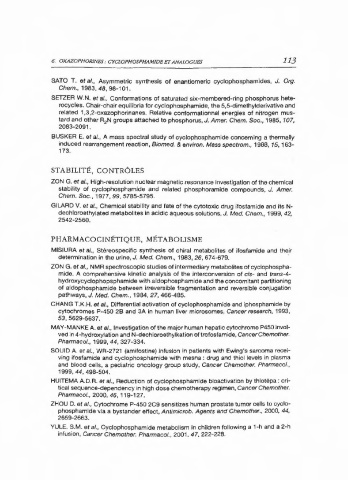Page 157 - Traité de chimie thérapeutique 6 Médicaments antitumoraux
P. 157
6. OXAZOPHORINES : CYCLOPHOSPHAMIDE ETANALOGUES 113
SATO T. et al., Asymmetric synthesis of enantiomeric cyclophosphamides, J. Org.
Chem., 1983, 48, 98-101.
SETZER W.N. et al., Conformations of saturated six-membered-ring phosphorus hete-
rocycles. Chair-chair equilibria for cyclophosphamide, the 5,5-dimethylderivative and
related 1,3,2-oxazophorinanes. Relative conformationnal anergies of nitrogen mus-
tard and other R,N groups attached to phosphorus, J. Amer. Chem. Soc., 1985, 107,
2083-2091.
BUSKER E. et al., A mass spectral study of cyclophosphamide conceming a thermally
induced rearrangement reaction, Biomed. & environ. Mass spectrom., 1988, 15, 163-
173.
STABILITÉ, CONTRÔLES
ZON G. et al., High-resolution nuclear magnetic resonance investigation of the chemical
stability of cyclophosphamide and related phosphoramide compounds, J. Amer.
Chem. Soc., 1977, 99, 5785-5795.
GILARD V. et al., Chemical stability and fate of the cytotoxic drug ifosfamide and its N-
dechloroethylated metabolites in acidic aqueous solutions, J. Med. Chem., 1999, 42,
2542-2560.
PHARMACOCINÉTIQUE, MÉTABOLISME
MISIURA et al., Stéreospecific synthesis of chiral metabolites of ifosfamide and their
determination in the urine, J. Med. Chem., 1983, 26, 674-679. '
ZON G. et al., NMR spectroscopie studies of intermediary metabolites of cyclophospha-
mide. A comprehensive klnetic analysis of the interconversion of cls- and trans-4-
hydroxycyclophopsphamide with aldophosphamide and the concomitant partitioning
of aldophosphamide between irreversible fragmentation and reverslble conjugation
pathways, J. Med. Chem., 1984, 27, 466-485.
CHANG T.K.H. et al., Differential activation of cyclophosphamide and iphosphamide by
cytochromes P-450 2B and 3A in human liver microsomes, Cancer research, 1993,
53, 5629-5637.
MAY-MANKE A. et al., Investigation of the major human hepatic cytochrome P450 invol-
ved in 4-hydroxylation and N-dechloroethylkation of trofosfamide, CancerChemother.
Pharmacol., 1999, 44, 327-334.
SOUID A. et al., WR-2721 (amifostine) infusion in patients with Ewing's sarcoma recei-
ving ifosfamide and cyclophosphamide with mesna : drug and thiol levels in plasma
and blood cells, a pediatric oncology group study, Cancer Chemother. Pharmacol.,
1999, 44, 498-504.
HUITEMA A.D.R. et al., Reduction of cyclophosphamide bioactivation by thiotépa : cri-
tical sequence-dependency in high dose chemotherapy regimen, CancerChemother.
Pharmacol., 2000, 46, 119-127.
ZHOU D. et al., Cytochrome P-450 2C9 sensitizes human prostate tumor cells to cyclo-
phosphamide via a bystander affect, Antimicrob. Agents and Chemother., 2000, 44,
2659-2663.
YULE. S.M. et al., Cyclophosphamide metabolism in children following a 1-handa2-h
infusion, Cancer Chemother. Pharmacol., 2001, 47, 222-228.

